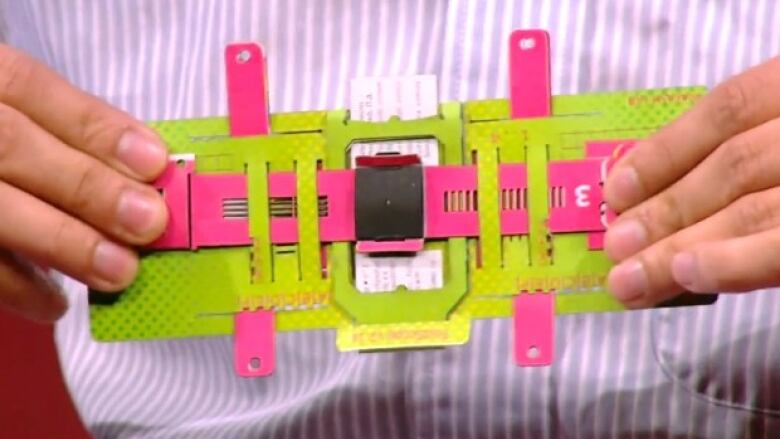Foldscope paper microscope can diagnose malaria, costs 50 cents
Rugged 'Foldscope' targeted at the developing world

A cheap, rugged microscope made of paper that performs as well as many commercial research microscopes could soon be yours.
The Foldscope can be assembled by punching out parts and folding them from a single sheet of layered cardstock.
"These [are] little microscopes that are literally built out of paper, tape and glue," said Manu Prakash, the device's creator, in a video interview posted this week by Stanford University, where he is an assistant professor of bioengineering.
"They're as good as many research microscopes that you can buy."
Prakash announced Thursday on Stanford's Scope blog that he is giving away 10,000 of his build-your-own paper microscope kits to citizen scientists with "the most inspiring ideas" about what to do with them. The Ten Thousand Microscopes Project is being funded by the Gordon and Betty Moore Foundation.
Prakash originally designed the Foldscope to detect deadly blood-borne diseases such as malaria, African sleeping sickness, schistosomiasis and Chagas in the developing world, which includes India, where he grew up. According to the World Health Organization, globally there were 219 million cases of malaria alone in 2010, and about 660,000 were fatal.
Many of those diseases are diagnosed by checking for parasites in a drop of a patient's blood using a microscope.
The problem is that microscopes are typically heavy, bulky, hard-to-maintain and expensive, so they are not often used in developing countries, Prakash said in a presentation featured this week on the TED Talks website.
Prakashwanted to invent a cheap alternative that could be mass produced with ordinary materials.
The end product, the Foldscope, costs just 45 to 55 cents to make.
"After one use, you could throw the entire microscope away," Prakash said in Stanford's video interview.
The paper material can be mass produced and individual microscopes are easily assembled by punching out and folding components from a single sheet of layered cardstock.
Magnifies samples 2,000 times
Normally, one of the more expensive parts on a traditional microscope is the lens. The Foldscope's lens is completely different acheap poppy seed-sized spherical beadembedded right in the paper.
The small, flat, finished product includes a microscope slide holder. According to Stanford University's Scope blog, the Foldscope can magnify samples up to 2,000 times.
Samples can be viewed by holding the lens up to your eye or by using light to project the image onto the wall. The paper components include sliders to adjust the sample position in three directions.
The microscope can be customized with accessories such as filters for specialized uses, such as malaria diagnosis.
In the Stanford video, Prakash demonstrates that despite the fact that the Foldscope is cheap enough to be disposable, the finished microscope can survive being stomped on, being dropped several stories from a window, or being immersed in water.
Prakash received a $100,000 grant from the Bill & Melinda Gates Foundation in 2012 to conduct field tests in India, Thailand and Uganda. According to the Scope blog, he has also recently been using it to teach his students about the physics of microscopy. He hopes to mass produce it not just for medical use, but also as an educational tool to inspire children.












_(720p).jpg)


 OFFICIAL HD MUSIC VIDEO.jpg)
.jpg)



























































































